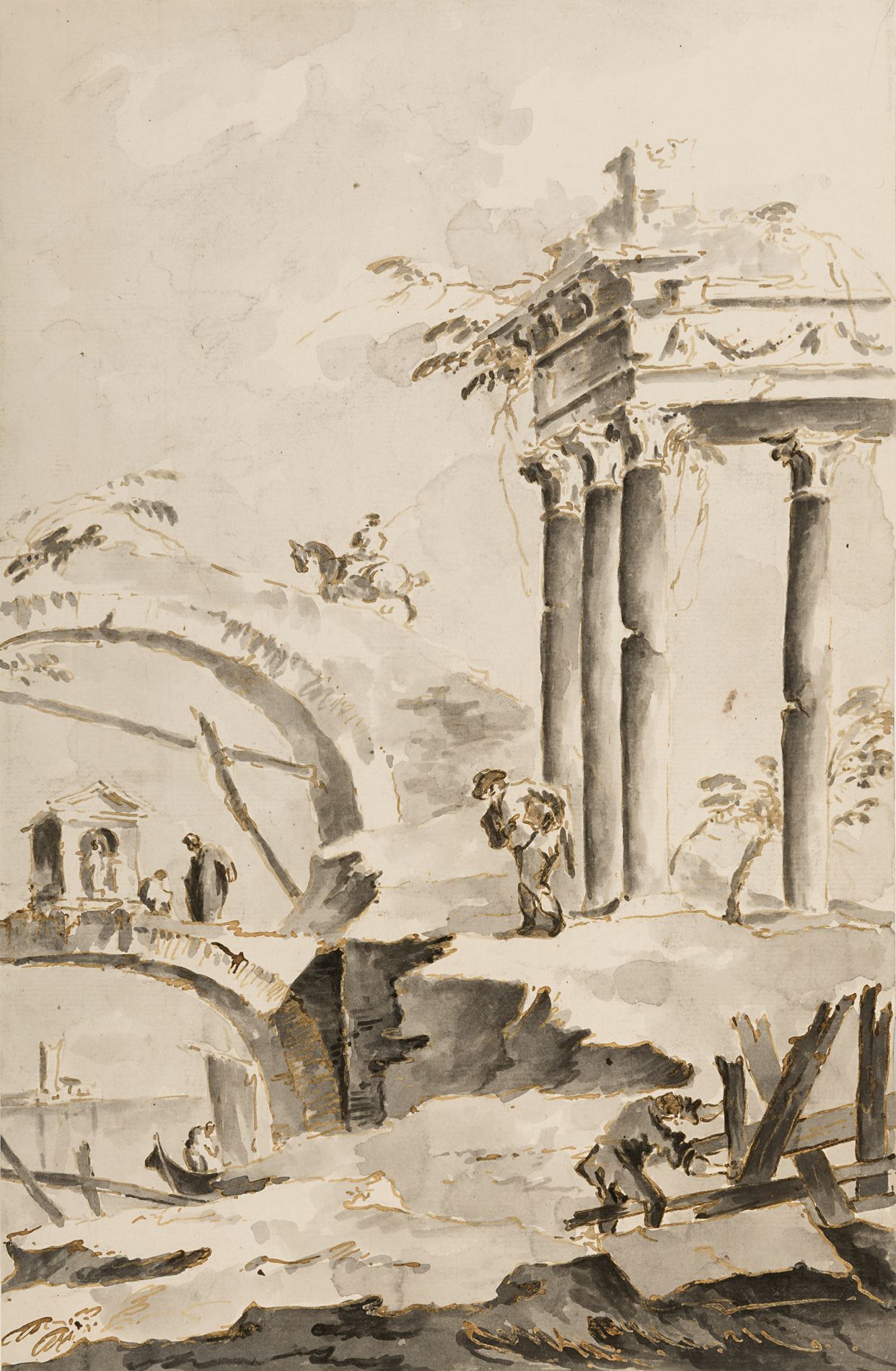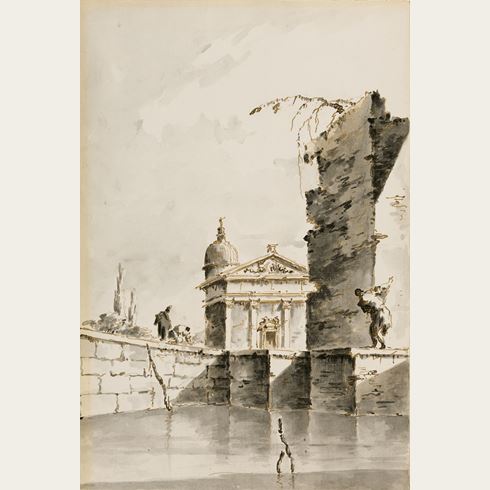Giacomo GUARDI
(Venice 1764 - Venice 1835)
A Capriccio Landscape with Ruins and Two Arches
Sold
Pen and brown and grey ink and grey wash, over traces of an underdrawing in black chalk.
461 x 300 mm. (18 1/8 x 11 3/4 in.)
461 x 300 mm. (18 1/8 x 11 3/4 in.)
These capriccio drawings by Giacomo Guardi are similar in style, as well as in dimensions, to a group of six large drawings of this type from the collection of Henry Oppenheimer that were sold at auction in 1936. According to a note by K. T. Parker in the Oppenheimer sale catalogue, the drawings all came from an album whose title page noted that it had been bought in Venice by Vice-Admiral Lord Mark Kerr (1776-1840), the son of the 5th Marquess of Lothian and an amateur draughtsman. It is not known precisely when the Kerr album was broken up - probably sometime in the 1920s - but by 1936 several drawings from the album were known in various collections.
All on a particularly large scale, the drawings in the Kerr album were almost certainly acquired as works by Francesco Guardi, but instead appear to be largely by Giacomo Guardi, and to be copies or derivations of original compositions by his father. Two large capriccio drawings which may have come from the Kerr album are in the Robert Lehman Collection at the Metropolitan Museum of Art in New York. The first of these, depicting a ruined colonnade with figures, has been tentatively identified by James Byam Shaw as a collaborative work executed by both Francesco and Giacomo Guardi, with the former outlining the composition in pen and the latter adding the washes. The other Lehman drawing, a Capriccio with a Statue of a Warrior and a Ruined Castle on the Shore of a Lagoon that is attributed to Giacomo alone, is particularly close in style and technique to the present pair of capricci. Two further comparable drawings of this type, albeit slightly larger than the drawings from the Kerr album, are in the National Gallery of Art in Washington, D.C., while a similar large-scale drawing of A Venetian Cloister is in the Kupferstichkabinett in Berlin. Several other capriccio drawings of this type and size by Giacomo Guardi have also appeared at auction.
In large drawings such as this and the preceding sheet, Giacomo Guardi was following the example of his father, whose pen and wash drawings of architectural capricci were extremely popular with collectors. As Filippo Pedrocco has noted of the younger Guardi, ‘in his more demanding works there is a sort of vivacity that is completely lacking in most of the numerous small-sized capriccios attributed to him. The general impression is that when he still had his father’s teaching clearly before him he was able to produce a series of paintings of a certain quality but then descended into mediocrity during the last years of his life.’
The composition of the present sheet may have been partly inspired by a late capriccio painting by Francesco Guardi, today in a private Venetian collection.
All on a particularly large scale, the drawings in the Kerr album were almost certainly acquired as works by Francesco Guardi, but instead appear to be largely by Giacomo Guardi, and to be copies or derivations of original compositions by his father. Two large capriccio drawings which may have come from the Kerr album are in the Robert Lehman Collection at the Metropolitan Museum of Art in New York. The first of these, depicting a ruined colonnade with figures, has been tentatively identified by James Byam Shaw as a collaborative work executed by both Francesco and Giacomo Guardi, with the former outlining the composition in pen and the latter adding the washes. The other Lehman drawing, a Capriccio with a Statue of a Warrior and a Ruined Castle on the Shore of a Lagoon that is attributed to Giacomo alone, is particularly close in style and technique to the present pair of capricci. Two further comparable drawings of this type, albeit slightly larger than the drawings from the Kerr album, are in the National Gallery of Art in Washington, D.C., while a similar large-scale drawing of A Venetian Cloister is in the Kupferstichkabinett in Berlin. Several other capriccio drawings of this type and size by Giacomo Guardi have also appeared at auction.
In large drawings such as this and the preceding sheet, Giacomo Guardi was following the example of his father, whose pen and wash drawings of architectural capricci were extremely popular with collectors. As Filippo Pedrocco has noted of the younger Guardi, ‘in his more demanding works there is a sort of vivacity that is completely lacking in most of the numerous small-sized capriccios attributed to him. The general impression is that when he still had his father’s teaching clearly before him he was able to produce a series of paintings of a certain quality but then descended into mediocrity during the last years of his life.’
The composition of the present sheet may have been partly inspired by a late capriccio painting by Francesco Guardi, today in a private Venetian collection.
The youngest son of the view painter Francesco Guardi, Giacomo Guardi assisted his father in the latter part of the elder artist’s career, contributing to the Venetian vedute for which he was well known. As James Byam Shaw has pointed out, ‘Through his father’s elder sister Cecilia, the wife of Giovanni Battista Tiepolo, he was first cousin to Domenico Tiepolo, though thirty-seven years his junior, and like Domenico he was a devoted assistant to his father so long as Francesco lived.’1 Giacomo inherited Francesco Guardi’s studio after his death in 1793, and seems to have spent several years selling the remains of his father’s output to foreign collectors on the Grand Tour, and sometimes completing unfinished works. As another scholar has noted, Giacomo ‘continued his father’s activity well past the beginning of the new century, but without having either the elder’s instinctive poetic vein or his inimitable talent as a painter.’
By the turn of the century, Giacomo had developed a particular specialty of small-scale views of Venice, executed either in pen and grey wash or gouache, which were intended as souvenirs for sale to less affluent visitors to the city. These gouache drawings proved highly popular with foreign tourists, and several albums of these views made their way to England, Ireland and France in the early years of the 19th century. (After a visit to Venice in 1816, Lady Anne Elizabeth Cholmley Murray noted, in her A Journal of a Tour in Italy, published anonymously and privately in five volumes in 1836, that ‘Gardi [sic] the son of the painter of that name, does views in distemper in the same style.’) Frequently, though not invariably, inspired by his father’s compositions, these gouaches by Giacomo are generally signed and inscribed on the verso with the location depicted and, very often, the artist’s address in Venice (‘all’ Ospedaletto in Calle del Peruchier al no.5245’). It is interesting to note that in these works the artist often signed his name with the noble form ‘Giacomo de Guardi’, taking advantage of a patent of nobility granted to the Guardi family by the Holy Roman Emperor Ferdinand III several generations earlier, in 1643.
In 1829, towards the end of his career, Giacomo Guardi sold a large number of drawings by his father, as well as many of his own studies, to the collector Teodoro Correr; these are now in the Museo Correr in Venice.
Provenance
Possibly part of an album of drawings acquired in Venice by Admiral Lord Mark Kerr, London
Anonymous sale, Paris, Hôtel Drouot, 6 June 2012, lot 95
Private collection.
Anonymous sale, Paris, Hôtel Drouot, 6 June 2012, lot 95
Private collection.







